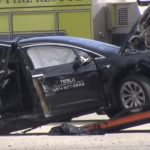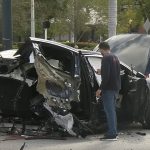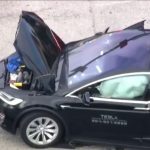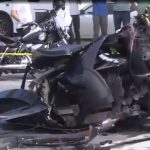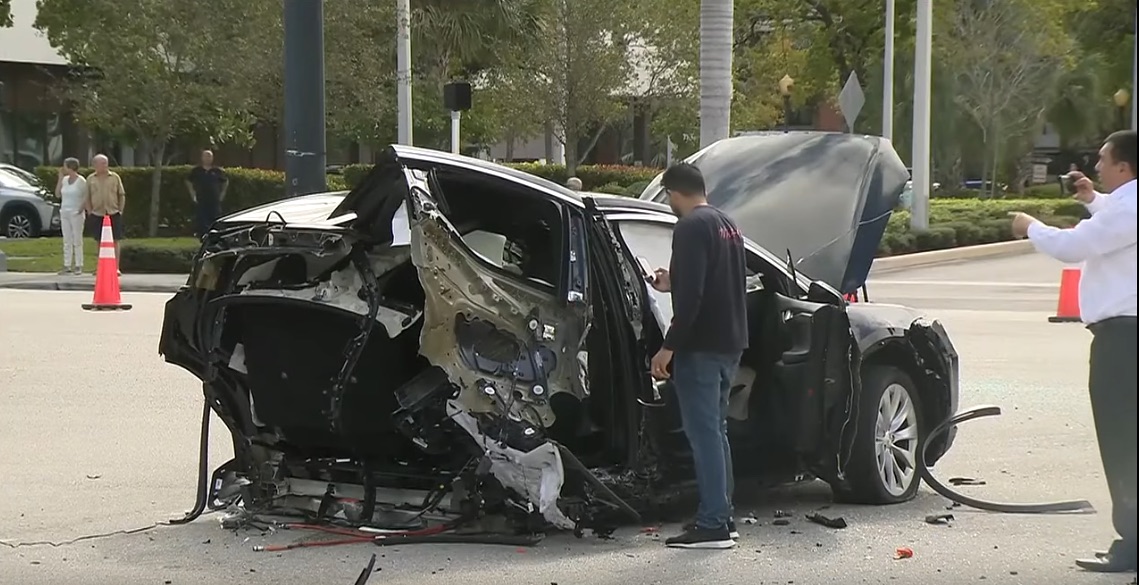
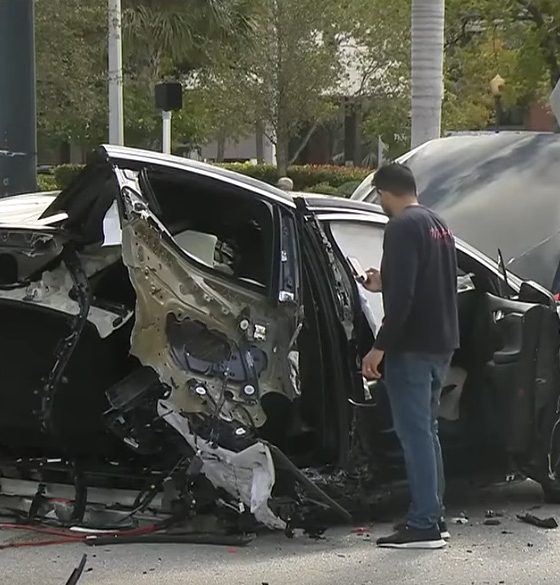
News
Tesla Model X splits in half after blindsided by Nissan GT-R, Tesla driver walks away unscathed
A serious car crash in Hallandale Beach, Florida left a Tesla Model X split in two after a Nissan GT-R alleged ran a red light before slamming into the all-electric SUV at high speed. The driver of the Model X walked away with a minor injury to his leg while the occupants of the other vehicle were brought to nearby hospitals for treatment and are expected to recover.
The driver of the Model X was identified as Jose Diaz who was seen counting his blessings moments after walking away from the incident. In a brief phone interview with 7News Miami, Diaz narrated that the Nissan came so fast that he didn’t even see it and that he just felt the bang.
Eyewitnesses to the scene recall seeing the white Nissan GT-R running through a red light at the intersection of Hallandale Beach Boulevard and Three Islands Boulevard before careening into the rear section of the Tesla Model X.
“I went over to help the guy in the white car, because the car had a lot of smoke, and I thought it was going to blow. He came out unscathed, and he was kissing the floor. It was a little blood coming from his nose, and he said, ‘Oh, I just wanna see my girl,’” said Tony Peart, a witness who approached to help the Tesla driver seconds after the wreck.
- Tesla Model X Florida car crash (Source: 7News Miami)
- Tesla Model X sheers in half after high speed crash (WPLG Local 10 | YouTube)
- Tesla Model X Florida car crash (Source: 7News Miami)
- Tesla Model X Florida car crash (Source: 7News Miami)
While it’s unfortunate to read about serious vehicular accidents, those involving a Tesla put into spotlight the all-electric carmaker’s award-winning safety features. It is very common to see SUVs involved in rollovers when involved in side-impact crashes because of their high center of gravity, but the opposite is true for Tesla vehicles and the Model X. With its low-mounted skateboard design battery pack, the center of gravity is far lower than traditional combustion engine cars, making it virtually impossible to roll over in high-speed crash testing.
The battery pack outer casing also serves as an extra layer of structural rigidity for the vehicle. Combined with a hybrid of ultra-high-strength materials, and large crumple zones that absorb energy to protect occupants from harm, and it’s no wonder that Tesla owners have touted never buying another car other than a Tesla.
“I waited 4 years for this one and would wait 4 more if that is what it took to protect my family like this” recalls one Model X owner after his all-electric SUV saved his life and the lives of his family after being involved in a horrific crash.
The Tesla Model X was awarded a 5-star safety rating in every category by the National Highway Traffic Safety Administration since its debut. Last December, the Model X was a standout in its class for earning the highest overall rating to date in the 2018/2019 protocol of the European New Car Assessment Programme (Euro NCAP) for Large Off-Road Vehicles with a near-perfect score of 98 percent in Adult Occupant Protection category.
Tesla’s Q4 2019 Vehicle Safety Report revealed that its vehicles are still 3 to 4x safer compared to the average even without Autopilot and active safety features enabled. With Autopilot on, the numbers are even more impressive at one accident per 3.07 million miles driven compared to the NHTSA findings of one automobile crash per 479,000 miles in the United States.

Elon Musk
Starlink passes 9 million active customers just weeks after hitting 8 million
The milestone highlights the accelerating growth of Starlink, which has now been adding over 20,000 new users per day.

SpaceX’s Starlink satellite internet service has continued its rapid global expansion, surpassing 9 million active customers just weeks after crossing the 8 million mark.
The milestone highlights the accelerating growth of Starlink, which has now been adding over 20,000 new users per day.
9 million customers
In a post on X, SpaceX stated that Starlink now serves over 9 million active users across 155 countries, territories, and markets. The company reached 8 million customers in early November, meaning it added roughly 1 million subscribers in under seven weeks, or about 21,275 new users on average per day.
“Starlink is connecting more than 9M active customers with high-speed internet across 155 countries, territories, and many other markets,” Starlink wrote in a post on its official X account. SpaceX President Gwynne Shotwell also celebrated the milestone on X. “A huge thank you to all of our customers and congrats to the Starlink team for such an incredible product,” she wrote.
That growth rate reflects both rising demand for broadband in underserved regions and Starlink’s expanding satellite constellation, which now includes more than 9,000 low-Earth-orbit satellites designed to deliver high-speed, low-latency internet worldwide.
Starlink’s momentum
Starlink’s momentum has been building up. SpaceX reported 4.6 million Starlink customers in December 2024, followed by 7 million by August 2025, and 8 million customers in November. Independent data also suggests Starlink usage is rising sharply, with Cloudflare reporting that global web traffic from Starlink users more than doubled in 2025, as noted in an Insider report.
Starlink’s momentum is increasingly tied to SpaceX’s broader financial outlook. Elon Musk has said the satellite network is “by far” the company’s largest revenue driver, and reports suggest SpaceX may be positioning itself for an initial public offering as soon as next year, with valuations estimated as high as $1.5 trillion. Musk has also suggested in the past that Starlink could have its own IPO in the future.
News
NVIDIA Director of Robotics: Tesla FSD v14 is the first AI to pass the “Physical Turing Test”
After testing FSD v14, Fan stated that his experience with FSD felt magical at first, but it soon started to feel like a routine.

NVIDIA Director of Robotics Jim Fan has praised Tesla’s Full Self-Driving (Supervised) v14 as the first AI to pass what he described as a “Physical Turing Test.”
After testing FSD v14, Fan stated that his experience with FSD felt magical at first, but it soon started to feel like a routine. And just like smartphones today, removing it now would “actively hurt.”
Jim Fan’s hands-on FSD v14 impressions
Fan, a leading researcher in embodied AI who is currently solving Physical AI at NVIDIA and spearheading the company’s Project GR00T initiative, noted that he actually was late to the Tesla game. He was, however, one of the first to try out FSD v14.
“I was very late to own a Tesla but among the earliest to try out FSD v14. It’s perhaps the first time I experience an AI that passes the Physical Turing Test: after a long day at work, you press a button, lay back, and couldn’t tell if a neural net or a human drove you home,” Fan wrote in a post on X.
Fan added: “Despite knowing exactly how robot learning works, I still find it magical watching the steering wheel turn by itself. First it feels surreal, next it becomes routine. Then, like the smartphone, taking it away actively hurts. This is how humanity gets rewired and glued to god-like technologies.”
The Physical Turing Test
The original Turing Test was conceived by Alan Turing in 1950, and it was aimed at determining if a machine could exhibit behavior that is equivalent to or indistinguishable from a human. By focusing on text-based conversations, the original Turing Test set a high bar for natural language processing and machine learning.
This test has been passed by today’s large language models. However, the capability to converse in a humanlike manner is a completely different challenge from performing real-world problem-solving or physical interactions. Thus, Fan introduced the Physical Turing Test, which challenges AI systems to demonstrate intelligence through physical actions.
Based on Fan’s comments, Tesla has demonstrated these intelligent physical actions with FSD v14. Elon Musk agreed with the NVIDIA executive, stating in a post on X that with FSD v14, “you can sense the sentience maturing.” Musk also praised Tesla AI, calling it the best “real-world AI” today.
News
Tesla AI team burns the Christmas midnight oil by releasing FSD v14.2.2.1
The update was released just a day after FSD v14.2.2 started rolling out to customers.

Tesla is burning the midnight oil this Christmas, with the Tesla AI team quietly rolling out Full Self-Driving (Supervised) v14.2.2.1 just a day after FSD v14.2.2 started rolling out to customers.
Tesla owner shares insights on FSD v14.2.2.1
Longtime Tesla owner and FSD tester @BLKMDL3 shared some insights following several drives with FSD v14.2.2.1 in rainy Los Angeles conditions with standing water and faded lane lines. He reported zero steering hesitation or stutter, confident lane changes, and maneuvers executed with precision that evoked the performance of Tesla’s driverless Robotaxis in Austin.
Parking performance impressed, with most spots nailed perfectly, including tight, sharp turns, in single attempts without shaky steering. One minor offset happened only due to another vehicle that was parked over the line, which FSD accommodated by a few extra inches. In rain that typically erases road markings, FSD visualized lanes and turn lines better than humans, positioning itself flawlessly when entering new streets as well.
“Took it up a dark, wet, and twisty canyon road up and down the hill tonight and it went very well as to be expected. Stayed centered in the lane, kept speed well and gives a confidence inspiring steering feel where it handles these curvy roads better than the majority of human drivers,” the Tesla owner wrote in a post on X.
Tesla’s FSD v14.2.2 update
Just a day before FSD v14.2.2.1’s release, Tesla rolled out FSD v14.2.2, which was focused on smoother real-world performance, better obstacle awareness, and precise end-of-trip routing. According to the update’s release notes, FSD v14.2.2 upgrades the vision encoder neural network with higher resolution features, enhancing detection of emergency vehicles, road obstacles, and human gestures.
New Arrival Options also allowed users to select preferred drop-off styles, such as Parking Lot, Street, Driveway, Parking Garage, or Curbside, with the navigation pin automatically adjusting to the ideal spot. Other refinements include pulling over for emergency vehicles, real-time vision-based detours for blocked roads, improved gate and debris handling, and Speed Profiles for customized driving styles.
